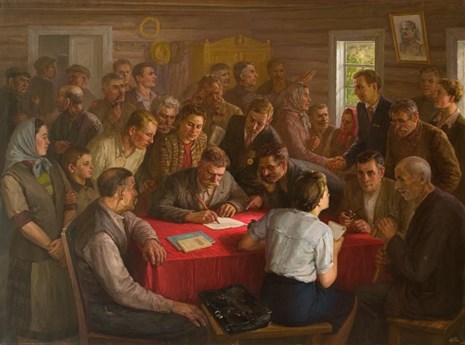The year 1950 was crucial in the collectivisation of Lithuanian agriculture. That was when Vincas Dilka, the head of the Drawing Department at Kaunas Institute of Art, exhibited his latest workThe Founding Meeting of a Collective Farmat the anniversary exhibition of Vilnius Institute of Art. Just two years previously only 4 per cent of all privately owned farms were collectivised, while by the time of the painting's unveiling, almost 80 per cent of farms had been absorbed into collective farms. This development was not caused by farmers' desire to give up their property, but by the radical actions of the Soviet government. The biggest wave of deportations to Siberia affected 100,000 people over those two years. In this context, Dilka's painting is a perfect example of Socialist Realism, in which we see the ideological requirements of the period at work, as well as the external features of the trend: its naturalism, its straightforward illustration, its well-developed literary narrative, and its bland colours.
Looking at the painting, any contemporary of Dilka's would have been able to read the the story, easily separating its ideologically commissioned layer. The young woman with a briefcase, dressed in an urban style, is a journalist from a large town. She is writing a report on the recent glorious achievements of collectivisation. Two men in suits are Party activists from the regional centre. One of them is still wearing the ribbons of his military medals, despite the fact that it is five years since the Second World War ended. The second is showing a medal he won during the years of peace, probably for his outstanding work. In the upper right-hand corner, a dubious whiskered man is being lectured to by his neighbour, who is already a member of a collective farm. In the left-hand corner, kulaks leave the meeting with angry faces through an open door, while the entire process is being watched over by a portrait of Stalin displayed in the place of honour in this room in a country house. It is evident that the artist had to go along with the strict rules of the regime.
The Founding Meeting of a Collective Farmwas Dilka's most popular work, and it was exhibited on several occasions and reproduced in various publications until 1975, when its overt ideological agenda became unacceptable even in the culture of mature socialism.



